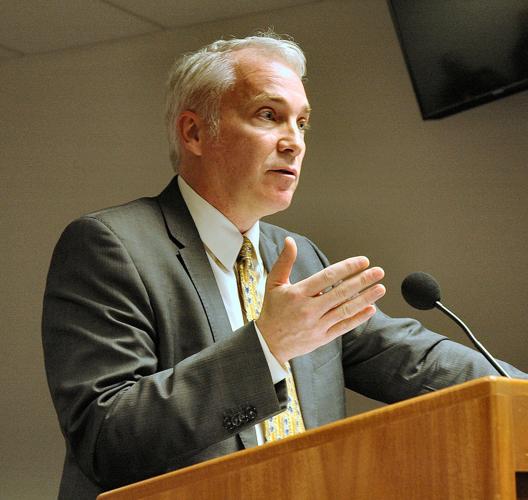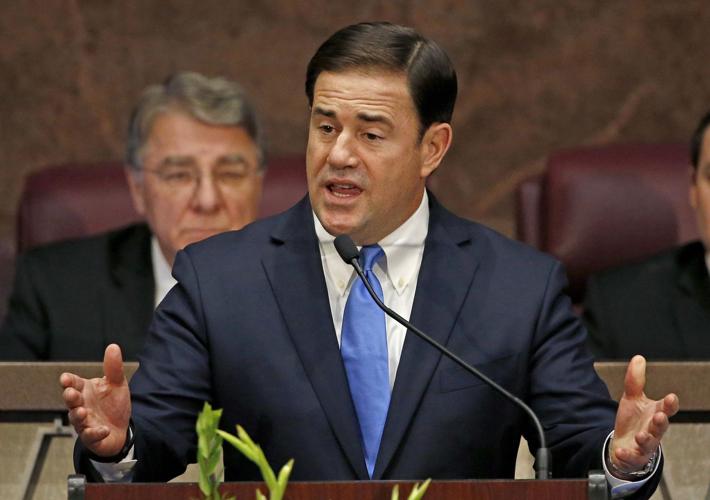The legislative session began with signs of a more collaborative way of doing business at the Capitol.
Gov. Doug Ducey’s state of the state speech emphasized priorities that pleased Democrats — education and social issues.
New Republican leaders of the House and Senate gave Democratic bills a chance.
But when it came down to the rough dealing in the last weeks of the session on the issue that mattered most — K-12 education and teacher pay — the two parties went their own ways and the ruling party got its way.
The resulting budget features marginally improved funding for education and teachers specifically, rather than a big boost to teachers, and passage of a few pet projects favored by key Republicans.
Ducey’s staff and supporters say the budget passed last week is a big win for education in Arizona. It includes a 1 percent pay raise for teachers each of the next two years, and about $38 million for performance-based funding for schools with high test scores.
“We see it as a step in the right direction,” Ducey spokesman Daniel Scarpinato told me. “It’s not the end of the road. He’d like to see more money go to teachers’ salaries.”
Eileen Sigmund, director of the Arizona Charter School Association, which is largely allied with Republicans, emerged content from the session, especially with the performance-funding money.
“Our charter schools were created to improve school achievement and provide choice,” she said Tuesday. The budget “delivers and supports the schools that create the best outcomes for kids.”
They were on the winning side. Their implication was that the right ideas won. And they have a right to that point of view.
But it was also a simple question of might winning. In Arizona, the might is on the right. So in the end, teachers and schools got ... something, not a lot.
A bit of cross-party negotiation occurred before this seemingly inevitable conclusion was reached. Much of it was over the plan for the universities to float $1 billion worth of bonds in order to pay for deferred maintenance and new research facilities.
The Democrats went to the governor and said they would support his university plan, which at the time lacked Republican votes, if he would support a 4 percent raise for teachers and a resumption of two years of eligibility, instead of one, for the Temporary Assistance for Needy Families program.
“We had an opportunity to give teachers a 4 percent raise,” Joe Thomas, president of the Arizona Education Association, said. “Instead of that, the governor decided he wanted to fund some pet projects and work backroom deals to get his budget passed.”
The governor’s side would say that isn’t true. The Democrats came in with unrealistic demands and wouldn’t budge, so the governor simply went a different route and dealt with Republicans to get the deals done and the budget passed.
But the Democrats said, in the end, they are Democrats. They’re a minority. They don’t have real leverage or even a hand to overplay.
“We don’t have a hand. We’re the minority,” said Sen. Steve Farley, the Tucson Democrat who is assistant minority leader. “Republicans have the overwhelming majority and all the levers of power.”
The assistant minority leader in the House, Tucson Democratic Rep. Randy Friese, put it this way: “He chose to make small deals on pet projects with Republicans to get them on board, rather than have the Democratic caucus play a role.”
So, instead of forcing through bigger raises to appease Democrats, Ducey went to individual Republicans who were holding out their votes on the university bonding bill. Among the concessions they got were:
- A $12 million income-tax cut in the form of an increase in personal tax exemptions.
- A change in the law covering municipal sales-tax elections, meaning they will no longer be allowed in odd-numbered years.
- A couple million more going to the so-called “freedom schools” at the University of Arizona and ASU.
You may recall these are institutes at each school founded by wealthy conservatives to promote free-market and supply-side ideas, which also received special multimillion-dollar appropriations last year. So, instead of bigger raises for teachers demanded by Democrats in negotiations, we got those items demanded by certain Republicans. Not a great trade-off.
Dan Hunting, a senior policy analyst at ASU’s Morrison Institute, wrote a report that came out this month on Arizona’s teacher problem. He told me nothing the Legislature did this year is likely to make a big difference in terms of teacher recruitment and retention.
Even SB 1062, which eased certification requirements for people with expertise in a given field, is likely to bring into teaching many people who don’t end up staying, he said.
“A bunch of research has been done on alternate certifications,” he said. “You get a few people to go into the classroom and give it a try. They don’t stay around. They leave the classroom at a much higher rate.”
As to the raises, he said, “A 1 percent pay raise just means you aren’t falling behind as fast as you were.”
“Even if we had a 4 percent raise, which is what Dems wanted, it would take a lot of 4 percent raises to get us up to the national average.”
And pay is only one of several reasons teachers flee. Workload is another that could be addressed by increased funding.
But in the end, the party divide persisted in Phoenix, and the gains made by teachers and public schools were marginal.






